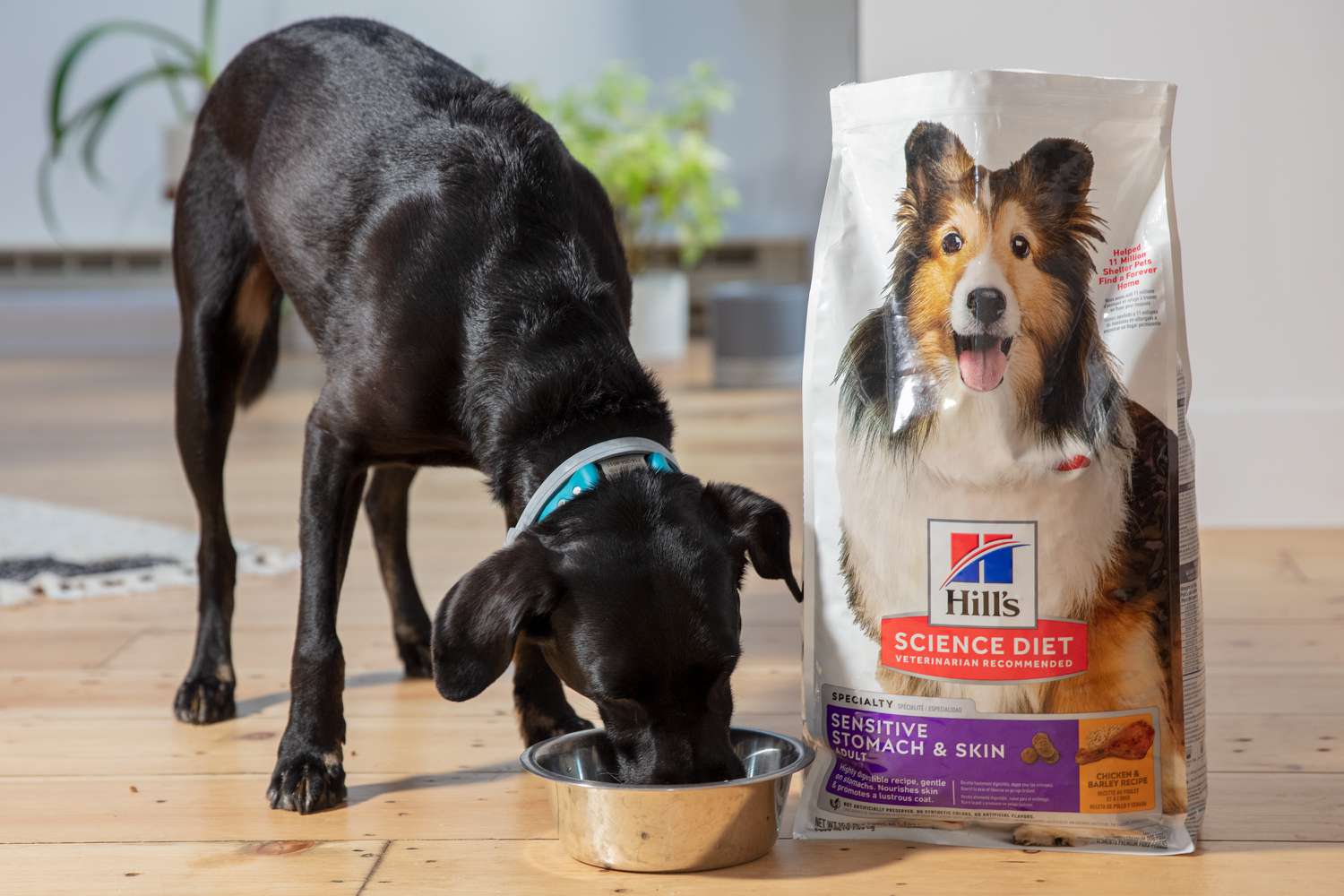Home>Health & Wellness>Common Health Issues>Which Dog Foods Cause Cancer


Common Health Issues
Which Dog Foods Cause Cancer
Published: February 4, 2024
Learn about common health issues in dogs and which dog foods may contribute to cancer. Find out how to keep your pet healthy and happy.
(Many of the links in this article redirect to a specific reviewed product. Your purchase of these products through affiliate links helps to generate commission for Pawsomeoldies.com, at no extra cost. Learn more)
Table of Contents
Introduction
The food we feed our furry companions plays a crucial role in their overall health and well-being. As loving pet owners, we strive to provide our dogs with the best nutrition to keep them happy and thriving. However, the unfortunate reality is that not all commercial dog foods are created equal. In recent years, concerns have been raised about the potential link between certain dog food ingredients and the development of cancer in dogs.
Understanding the impact of diet on canine health is essential for pet owners who want to make informed decisions about their pets' nutrition. This article aims to shed light on the common ingredients found in dog foods, the potential carcinogens that may be present, and the latest research on the connection between dog foods and cancer. Additionally, practical tips for selecting healthier dog foods will be provided to empower pet owners to make the best choices for their beloved companions.
By delving into this important topic, we can gain valuable insights into the potential risks associated with certain dog foods and take proactive steps to safeguard our dogs' health. Let's embark on this journey to unravel the intricate relationship between dog foods and cancer, ultimately empowering pet owners to make well-informed decisions for their furry friends' well-being.
Read more: What Causes Sarcoma Cancer In Dogs
Common Ingredients in Dog Foods
When it comes to commercial dog foods, it's essential to be aware of the common ingredients that are frequently used in their production. Understanding these components can provide valuable insights into the nutritional content and potential health implications for our canine companions. Here are some of the prevalent ingredients found in dog foods:
1. Meat By-Products
Meat by-products are often included in commercial dog foods. These can encompass organs, blood, bone, and other parts of animals that are not typically consumed by humans. While these by-products can be a source of essential nutrients for dogs, the quality and origin of the ingredients may vary significantly among different brands.
2. Grains
Grains such as corn, wheat, and soy are commonly used as fillers in dog foods. While these ingredients can provide energy and certain nutrients, they have also been a subject of debate regarding their potential impact on canine health. Some dogs may have sensitivities or allergies to specific grains, leading to digestive issues or skin problems.
3. Artificial Additives
Artificial preservatives, colors, and flavors are frequently added to enhance the palatability and shelf life of dog foods. However, certain synthetic additives have been associated with adverse health effects in dogs. For example, some artificial colors and preservatives have been linked to allergic reactions and behavioral changes in canines.
4. Meat Meals
Meat meals, such as chicken meal or beef meal, are concentrated sources of animal protein commonly used in dog foods. While these can be valuable protein sources, the quality and processing methods of meat meals can vary, impacting their nutritional value.
5. Fillers and Binders
Fillers and binders, such as cellulose and carrageenan, are used to modify the texture and consistency of dog foods. While these ingredients may serve functional purposes in food production, their inclusion and potential effects on canine health warrant careful consideration.
Understanding these common ingredients in dog foods is crucial for pet owners who seek to make informed choices about their pets' nutrition. By being aware of the components that make up commercial dog foods, pet owners can better evaluate the potential benefits and risks associated with different products, ultimately contributing to the overall well-being of their beloved canine companions.
Potential Carcinogens in Dog Foods
The presence of potential carcinogens in dog foods is a concerning aspect that has garnered attention within the veterinary and pet owner communities. Carcinogens are substances that have the potential to cause cancer in living tissues, and their inclusion in dog foods raises significant health considerations for our beloved pets. While the direct link between specific dog food ingredients and cancer development in dogs is still an area of ongoing research, several potential carcinogens have been identified in commercial dog foods. Understanding these substances is crucial for pet owners who aim to prioritize their dogs' health and well-being.
-
Aflatoxins: Aflatoxins are naturally occurring toxins produced by certain molds, particularly Aspergillus species. These toxins can contaminate grains and legumes used in dog foods, posing a risk of exposure to pets. Aflatoxins have been classified as carcinogenic to humans by the International Agency for Research on Cancer (IARC), and their potential impact on canine health is a subject of concern.
-
Heterocyclic Amines (HCAs): HCAs are a group of compounds that can form when meat is cooked at high temperatures, such as during the manufacturing process of dog foods. These compounds have been studied for their potential carcinogenic effects in humans and animals, raising questions about their presence in processed dog food products.
-
Bisphenol A (BPA): BPA is a chemical compound used in the production of certain plastics and epoxy resins, which can find its way into the packaging materials of dog foods. Research has indicated that BPA may have endocrine-disrupting properties and potential links to cancer development, prompting concerns about its presence in the food packaging that comes into contact with dog foods.
-
Acrylamide: Acrylamide is a chemical compound that can form in starchy foods when they are cooked at high temperatures, such as in the production of kibble and treats. Studies have suggested that acrylamide may have carcinogenic properties, raising awareness about its potential presence in processed dog foods.
-
Artificial Additives: Certain artificial preservatives and colors used in dog foods have been scrutinized for their potential health risks, including their possible contribution to cancer development. While the direct carcinogenic effects of these additives in dogs are still being investigated, their presence in commercial dog foods warrants careful consideration.
Understanding the potential carcinogens present in dog foods is essential for pet owners who seek to make informed decisions about their pets' nutrition. By being aware of these substances, pet owners can take proactive steps to minimize their pets' exposure to potential carcinogens, ultimately contributing to the promotion of their dogs' long-term health and well-being.
Studies on Dog Foods and Cancer
The relationship between dog foods and cancer has been a subject of growing interest among researchers and veterinary professionals. While the direct causative link between specific dog food ingredients and cancer development in dogs is still an area of ongoing investigation, several studies have provided valuable insights into this complex relationship.
One study published in the Journal of the American Veterinary Medical Association examined the potential association between certain dog food ingredients and the prevalence of cancer in canines. The researchers conducted a retrospective analysis of dietary patterns and cancer diagnoses in a large cohort of dogs. The findings revealed a potential correlation between the long-term consumption of dog foods containing high levels of certain artificial additives and an increased incidence of certain types of cancer in dogs. While further research is needed to establish a definitive causal relationship, these findings underscore the importance of scrutinizing the ingredients present in commercial dog foods.
In another study conducted at a leading veterinary research institution, the focus was on investigating the potential impact of aflatoxin contamination in dog foods on the development of liver cancer in dogs. The researchers utilized advanced analytical techniques to detect and quantify aflatoxin levels in various commercial dog food samples. The results indicated that a subset of the tested dog foods contained elevated levels of aflatoxins, raising concerns about the potential health risks posed to dogs. Subsequent epidemiological analyses revealed a notable association between the consumption of aflatoxin-contaminated dog foods and an increased incidence of liver cancer in the studied canine population.
Furthermore, a longitudinal cohort study published in a prominent veterinary science journal sought to elucidate the potential link between dietary exposure to heterocyclic amines (HCAs) and the development of gastrointestinal tumors in dogs. Through meticulous dietary assessments and health monitoring of a cohort of dogs over an extended period, the researchers observed a suggestive correlation between the consumption of dog foods with high HCA content and an elevated risk of gastrointestinal tumor development in certain breeds. These findings shed light on the potential impact of food processing methods on the formation of carcinogenic compounds and their implications for canine health.
These studies collectively highlight the significance of investigating the relationship between dog foods and cancer, emphasizing the need for comprehensive dietary assessments and rigorous scrutiny of commercial dog food ingredients. While further research is warranted to elucidate the precise mechanisms underlying this intricate relationship, the existing body of evidence underscores the importance of prioritizing the selection of high-quality, nutritionally balanced dog foods to mitigate potential health risks associated with cancer development in dogs.
Read more: Which Dogs Can Sense Cancer
Tips for Choosing a Healthier Dog Food
When it comes to selecting a healthier dog food for your beloved canine companion, several essential considerations can guide you in making informed choices that prioritize your pet's well-being. Here are valuable tips to help you navigate the diverse landscape of commercial dog foods and opt for options that promote optimal health for your furry friend:
-
Prioritize Whole Food Ingredients: Look for dog foods that feature whole food ingredients such as high-quality meats, fruits, and vegetables. Whole foods provide essential nutrients and are generally less processed, offering a more natural and wholesome dietary option for your dog.
-
Check for Nutritional Adequacy: Ensure that the dog food you choose complies with the nutritional standards set by reputable organizations such as the Association of American Feed Control Officials (AAFCO). Look for statements on the packaging indicating that the food is complete and balanced for your dog's life stage, whether it's for puppies, adult dogs, or seniors.
-
Avoid Artificial Additives: Opt for dog foods that are free from artificial preservatives, colors, and flavors. These additives have been associated with potential health risks and may not contribute to the overall nutritional value of the food. Choosing natural and minimally processed options can help minimize your dog's exposure to synthetic additives.
-
Consider Grain-Free Options: If your dog has specific dietary sensitivities or allergies, consider grain-free dog foods that utilize alternative sources of carbohydrates such as sweet potatoes or peas. While grains can be a valuable source of nutrients for many dogs, some may benefit from grain-free formulations.
-
Seek Transparency in Ingredients: Look for dog food brands that prioritize transparency in their ingredient sourcing and manufacturing processes. Brands that openly communicate the sources of their ingredients and adhere to rigorous quality control measures can instill confidence in the nutritional integrity of their products.
-
Consult with Your Veterinarian: Your veterinarian can provide valuable insights and recommendations tailored to your dog's specific nutritional needs. Consulting with a trusted veterinary professional can help you navigate the myriad of dog food options and make choices that align with your dog's individual health requirements.
-
Monitor Your Dog's Response: Upon transitioning to a new dog food, closely monitor your dog's response to the diet. Observe for any signs of digestive upset, skin reactions, or changes in energy levels. This proactive approach can help you assess the suitability of the chosen food for your dog.
By incorporating these tips into your decision-making process, you can take proactive steps to select a healthier dog food that aligns with your pet's nutritional needs and supports their overall health and vitality. Prioritizing high-quality, nutritionally balanced dog foods can contribute to your dog's long-term well-being and bring you peace of mind as a caring and responsible pet owner.
Conclusion
In conclusion, the relationship between dog foods and the potential risk of cancer development in dogs is a complex and multifaceted issue that warrants careful consideration. While the direct causative link between specific dog food ingredients and cancer in dogs is still an area of ongoing research, the presence of potential carcinogens in commercial dog foods raises significant concerns for pet owners who prioritize their dogs' health and well-being.
Understanding the common ingredients found in dog foods, including meat by-products, grains, artificial additives, meat meals, and fillers, provides valuable insights into the nutritional content and potential health implications for our canine companions. Additionally, being aware of potential carcinogens such as aflatoxins, heterocyclic amines, bisphenol A, acrylamide, and artificial additives in dog foods is crucial for pet owners seeking to make informed decisions about their pets' nutrition.
The existing body of research, including studies examining the association between certain dog food ingredients and cancer prevalence in dogs, underscores the importance of scrutinizing the ingredients present in commercial dog foods. These studies have shed light on potential correlations between long-term consumption of dog foods containing high levels of certain artificial additives and an increased incidence of certain types of cancer in dogs, as well as the impact of aflatoxin contamination and dietary exposure to heterocyclic amines on canine health.
To mitigate potential health risks associated with cancer development in dogs, pet owners can implement practical tips for choosing healthier dog foods. Prioritizing whole food ingredients, checking for nutritional adequacy, avoiding artificial additives, considering grain-free options, seeking transparency in ingredients, consulting with veterinarians, and monitoring dogs' responses to dietary changes are essential steps in selecting high-quality, nutritionally balanced dog foods that promote optimal health for our furry companions.
By taking proactive measures to minimize dogs' exposure to potential carcinogens and prioritizing the selection of healthier dog foods, pet owners can play a pivotal role in safeguarding their dogs' long-term well-being. As responsible and caring pet owners, it is our collective duty to stay informed, make thoughtful choices, and advocate for the best possible nutrition for our beloved canine companions.
In essence, the journey to unravel the intricate relationship between dog foods and cancer empowers pet owners to make well-informed decisions that prioritize their dogs' health and vitality, ultimately fostering a deeper bond and enhancing the quality of life for our cherished furry friends.













